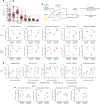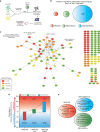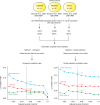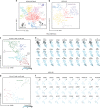Selective expansion of myeloid and NK cells in humanized mice yields human-like vaccine responses
- PMID: 30487575
- PMCID: PMC6262001
- DOI: 10.1038/s41467-018-07478-2
Selective expansion of myeloid and NK cells in humanized mice yields human-like vaccine responses
Abstract
Mice engrafted with components of a human immune system have become widely-used models for studying aspects of human immunity and disease. However, a defined methodology to objectively measure and compare the quality of the human immune response in different models is lacking. Here, by taking advantage of the highly immunogenic live-attenuated yellow fever virus vaccine YFV-17D, we provide an in-depth comparison of immune responses in human vaccinees, conventional humanized mice, and second generation humanized mice. We demonstrate that selective expansion of human myeloid and natural killer cells promotes transcriptomic responses akin to those of human vaccinees. These enhanced transcriptomic profiles correlate with the development of an antigen-specific cellular and humoral response to YFV-17D. Altogether, our approach provides a robust scoring of the quality of the human immune response in humanized mice and highlights a rational path towards developing better pre-clinical models for studying the human immune response and disease.
Conflict of interest statement
The authors declare no competing interests.
Figures









Similar articles
-
Molecular and immunological characterization of a DNA-launched yellow fever virus 17D infectious clone.J Gen Virol. 2015 Apr;96(Pt 4):804-814. doi: 10.1099/jgv.0.000026. Epub 2014 Dec 16. J Gen Virol. 2015. PMID: 25516543 Free PMC article.
-
Comparing immunogenicity and protective efficacy of the yellow fever 17D vaccine in mice.Emerg Microbes Infect. 2021 Dec;10(1):2279-2290. doi: 10.1080/22221751.2021.2008772. Emerg Microbes Infect. 2021. PMID: 34792431 Free PMC article.
-
Type III Interferon-Mediated Signaling Is Critical for Controlling Live Attenuated Yellow Fever Virus Infection In Vivo.mBio. 2017 Aug 15;8(4):e00819-17. doi: 10.1128/mBio.00819-17. mBio. 2017. PMID: 28811340 Free PMC article.
-
The yellow fever 17D virus as a platform for new live attenuated vaccines.Hum Vaccin Immunother. 2014;10(5):1256-65. doi: 10.4161/hv.28117. Epub 2014 Feb 19. Hum Vaccin Immunother. 2014. PMID: 24553128 Free PMC article. Review.
-
T Cell-Mediated Immunity towards Yellow Fever Virus and Useful Animal Models.Viruses. 2017 Apr 11;9(4):77. doi: 10.3390/v9040077. Viruses. 2017. PMID: 28398253 Free PMC article. Review.
Cited by
-
Immune Control and Vaccination against the Epstein-Barr Virus in Humanized Mice.Vaccines (Basel). 2019 Dec 17;7(4):217. doi: 10.3390/vaccines7040217. Vaccines (Basel). 2019. PMID: 31861045 Free PMC article. Review.
-
Generation and characterization of genetically and antigenically diverse infectious clones of dengue virus serotypes 1-4.Emerg Microbes Infect. 2022 Dec;11(1):227-239. doi: 10.1080/22221751.2021.2021808. Emerg Microbes Infect. 2022. PMID: 34931940 Free PMC article.
-
Targeted viral adaptation generates a simian-tropic hepatitis B virus that infects marmoset cells.Nat Commun. 2023 Jun 16;14(1):3582. doi: 10.1038/s41467-023-39148-3. Nat Commun. 2023. PMID: 37328459 Free PMC article.
-
Persistent hepatitis B virus and HIV coinfections in dually humanized mice engrafted with human liver and immune system.J Med Virol. 2023 Jul;95(7):e28930. doi: 10.1002/jmv.28930. J Med Virol. 2023. PMID: 37403703 Free PMC article.
-
Animal Models Used in Hepatitis C Virus Research.Int J Mol Sci. 2020 May 29;21(11):3869. doi: 10.3390/ijms21113869. Int J Mol Sci. 2020. PMID: 32485887 Free PMC article. Review.
References
Publication types
MeSH terms
Substances
Grants and funding
- R01 HL095791/HL/NHLBI NIH HHS/United States
- P30 CA072720/CA/NCI NIH HHS/United States
- T32 GM007753/GM/NIGMS NIH HHS/United States
- R01 AI079031/AI/NIAID NIH HHS/United States
- P01 AI039671/AI/NIAID NIH HHS/United States
- R33 CA202820/CA/NCI NIH HHS/United States
- T32 GM007388/GM/NIGMS NIH HHS/United States
- T32 GM008313/GM/NIGMS NIH HHS/United States
- U19 AI089992/AI/NIAID NIH HHS/United States
- U24 AI118672/AI/NIAID NIH HHS/United States
- U54 CA217377/CA/NCI NIH HHS/United States
- R01 AI138797/AI/NIAID NIH HHS/United States
- R01 HL134539/HL/NHLBI NIH HHS/United States
- RM1 HG006193/HG/NHGRI NIH HHS/United States
- R01 AI107301/AI/NIAID NIH HHS/United States
LinkOut - more resources
Full Text Sources
Other Literature Sources
Molecular Biology Databases
Research Materials

